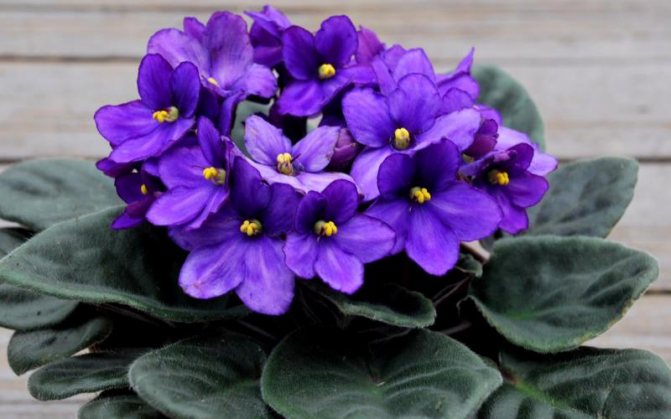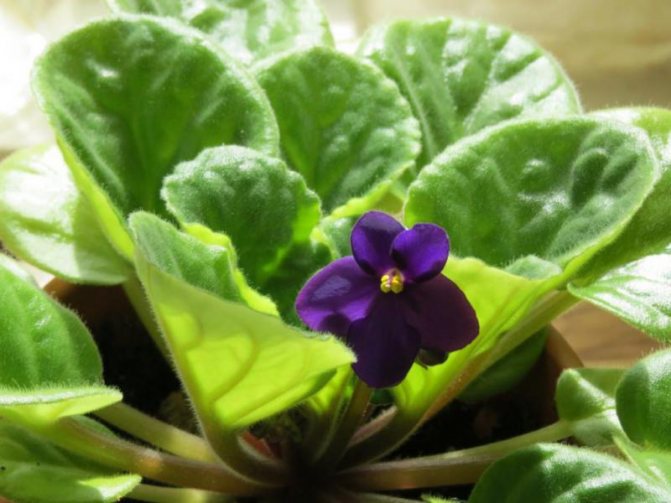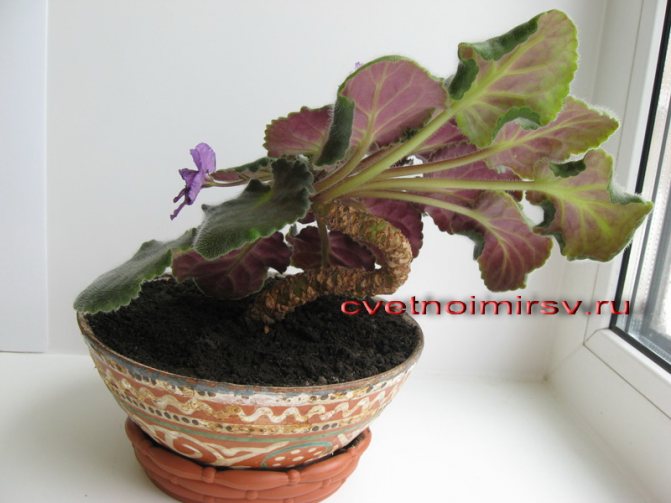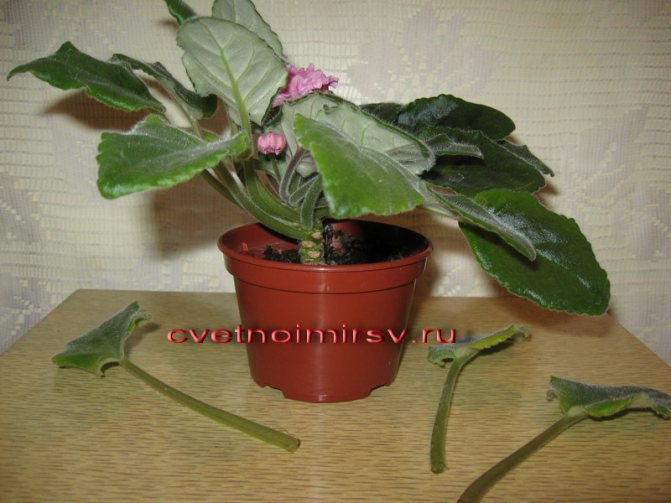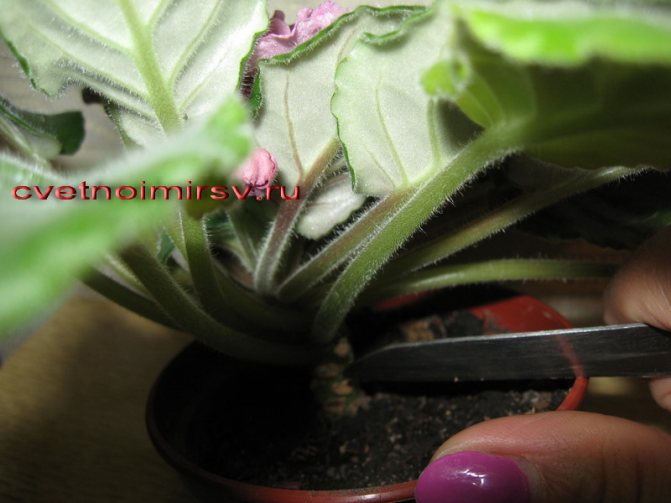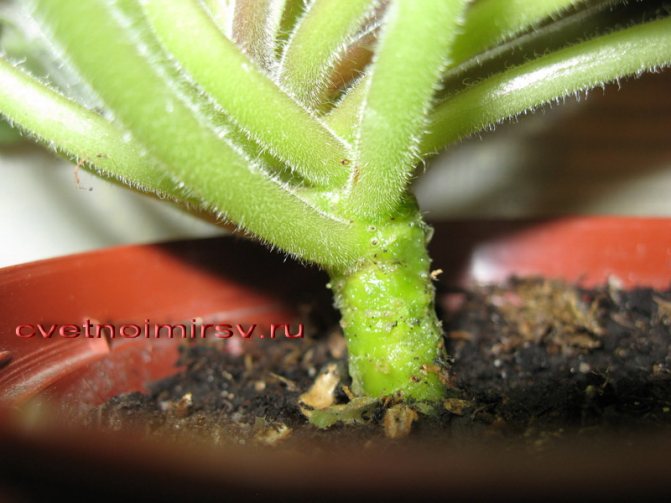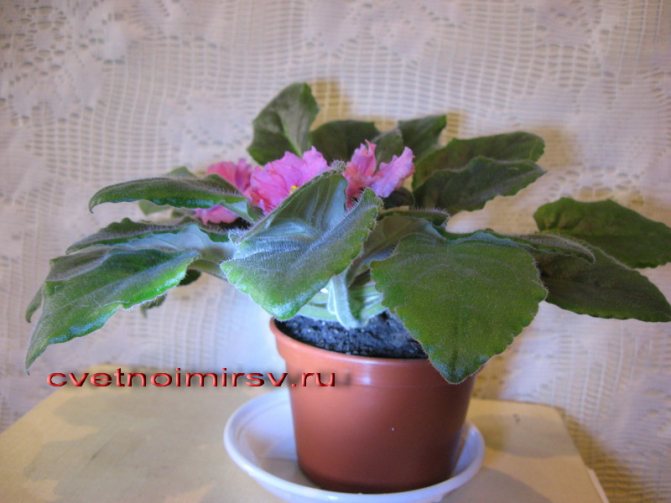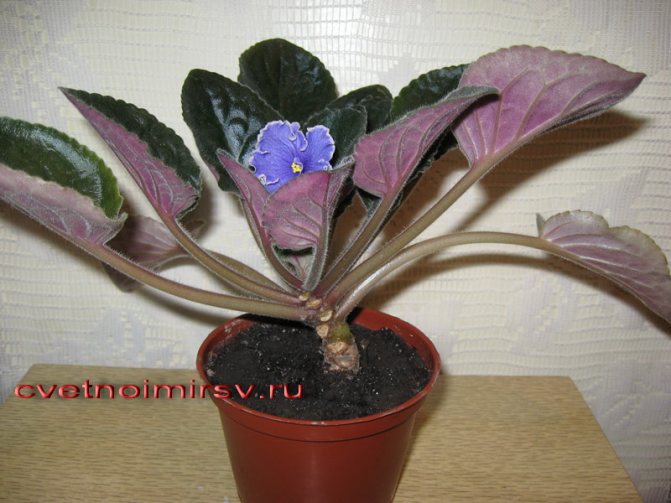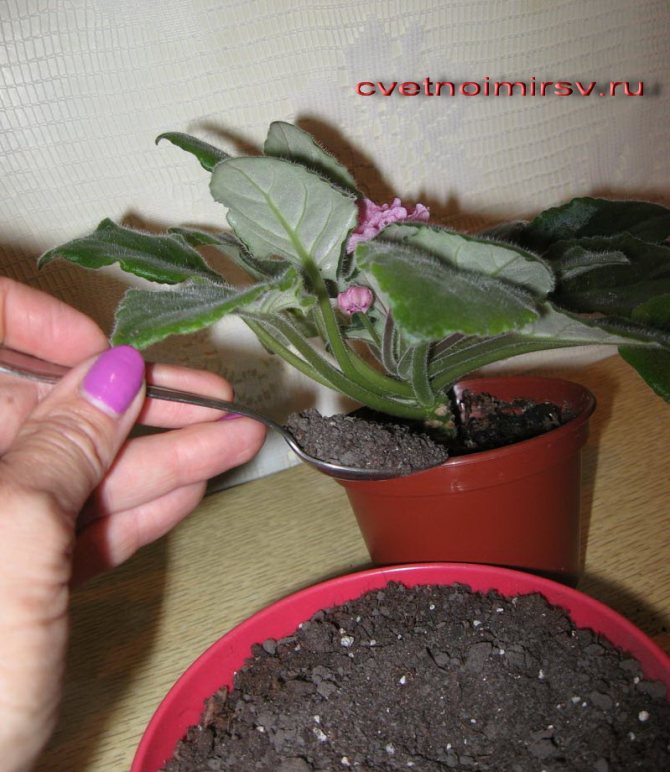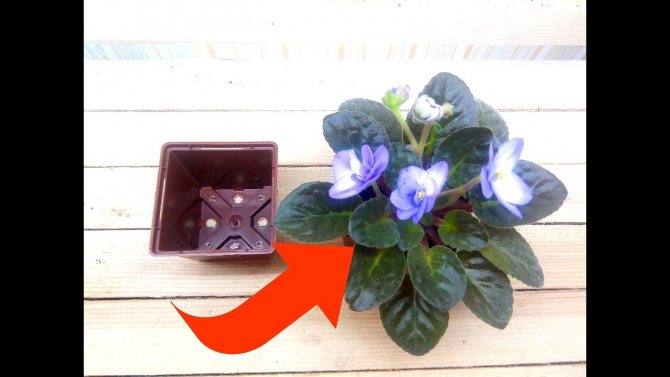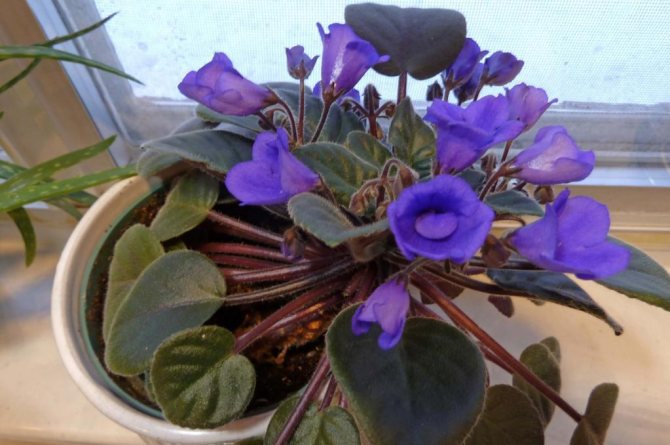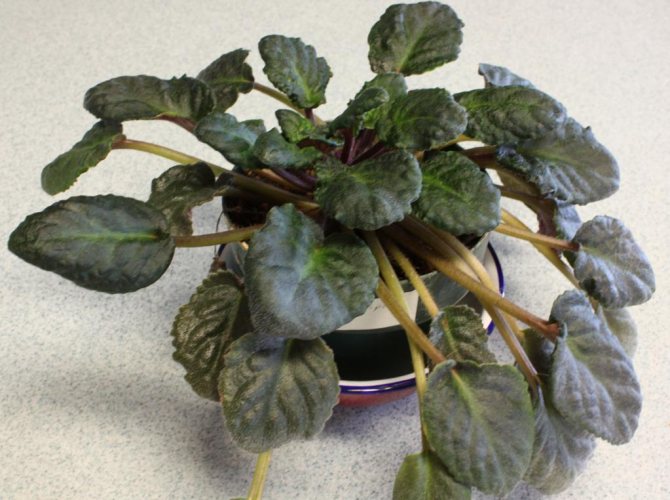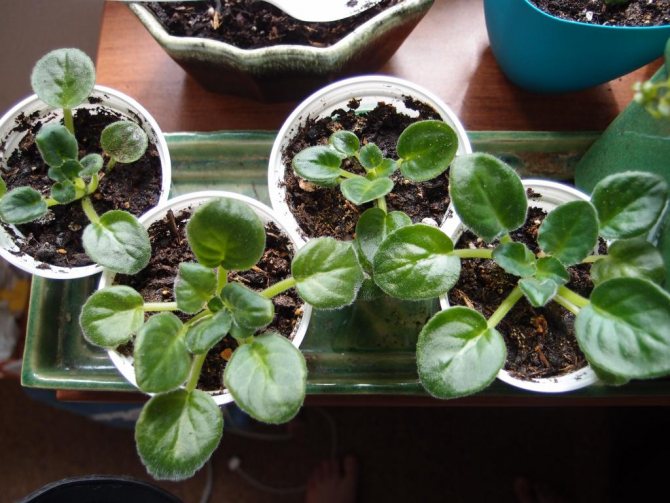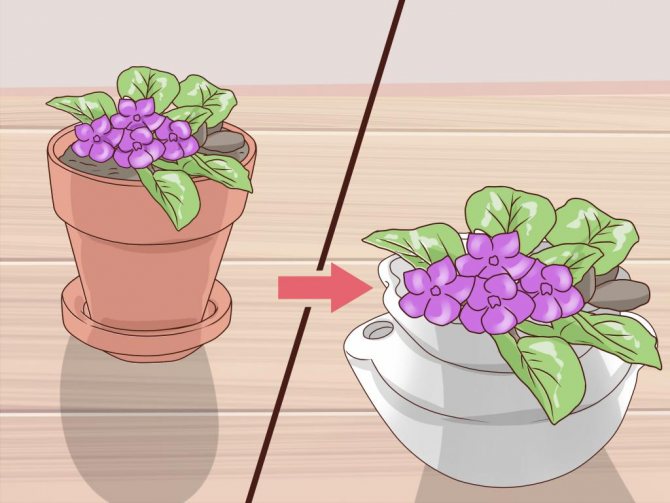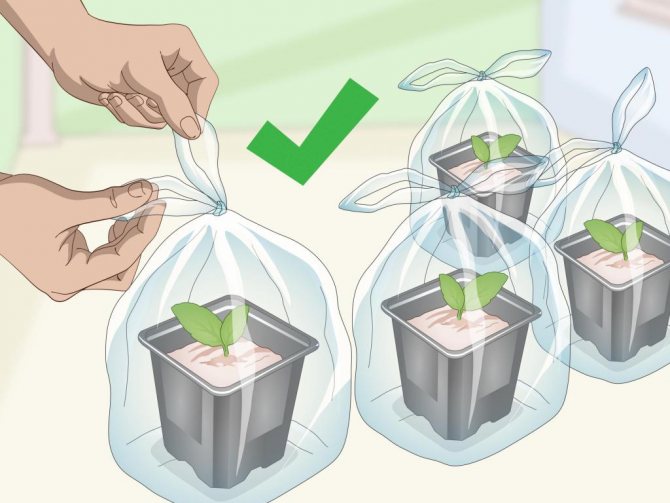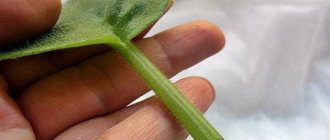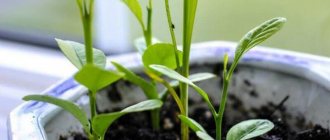So that indoor Saintpaulia grows well, blooms profusely and has an attractive appearance, it must be carefully looked after.
Constant feeding, timely watering, temperature conditions, as well as correctly selected soil and transplantation.
If the violet is rarely transplanted or planted in unsuitable soil, a rosette with leaves, flowering will be scarce or Saintpaulia will die altogether... In this article we will tell you how to transplant a violet at home step by step.
How to rejuvenate a violet
African violet (Saintpaulia) is susceptible to root rot when excessively wet, fears of drought. Growing in a pot that has bottom drainages to allow air and water to reach the roots of the plant is essential to prevent rotting and prolong the life of the plant. The rejuvenation procedure will help prolong flowering and restore beauty to indoor flowers.
When the potting mixture is saturated with moisture and does not dry out, drying the soil should help. It is necessary to remove the saintpaulia from the pot, soil and place it on several layers of newspaper or paper towels. Since the roots and leaves are fragile, the plant should be handled with care.
Blotting the edges of the root mass with paper towels is necessary to remove moisture. You need to check the roots for rot. Rotting roots are brown and slimy, while healthy ones are white. Decaying areas of the roots must be cut off with scissors.
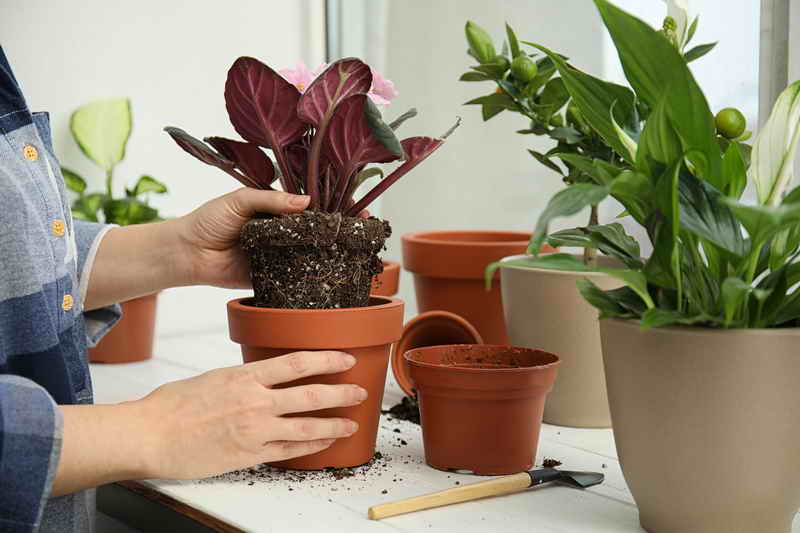
Violet care. Illustration for this article is used under a standard license.
Remove all lower leaves from the rosette using a pruning shear. There should be a minimum of green mass after processing. The cut must be powdered with wood ash to prevent the development of pathogens. The brown peel on the stems must be peeled to a green mass. The roots are dipped in a glass of warm water, left for 30 minutes. Allow the violet to dry for 12 hours. Then the treated plants are placed in small pots filled with water, over time, the flowers will release new, healthy roots.
The water is changed every 2-3 days, you can accelerate the growth of new roots using Kornevin, Zircon. The drugs are excellent growth stimulants. A structural analogue of auxin is added to the container, following the instructions on the package. When the roots reach 2-3 cm, you need to transplant the saintpaulia into pots. For rapid growth, greenhouse conditions are created by covering the flowers with foil or glass. If the rosette seems too wobbly in the soil, you can use toothpicks around the roots.
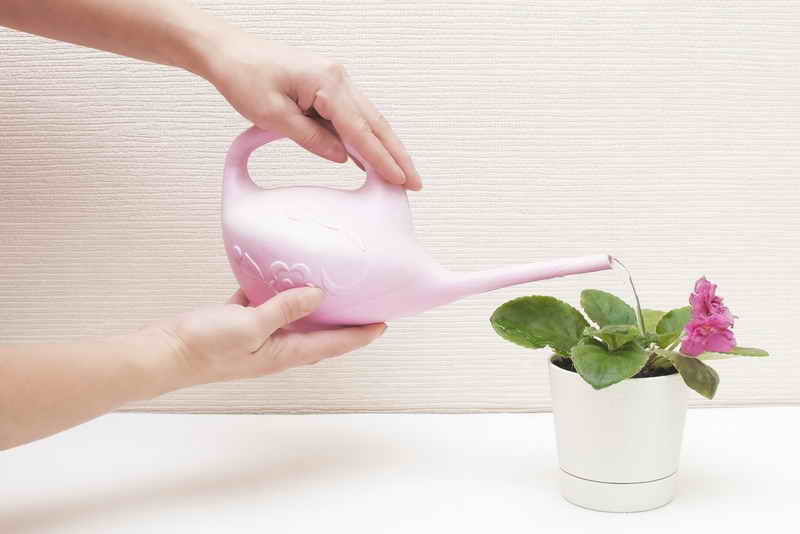

Watering violets. Illustration for this article is used under a standard license.
If the bare stem of the violet is more than 5 cm long, you need to re-root the upper part of the plant. Remove damaged or unhealthy looking old leaves, any open flowers or buds showing color. After a while, where the bare stem is in contact with moist soil roots, young roots are formed that grow into the soil. The stem should be planted directly below the lowest leaf.
The potting mixture gradually clogs up, the nutrients are washed out. This condition can lead to root rot.It is necessary to transplant the plant into fresh soil annually. Since the roots of African violets break easily, the plant should be carefully planted in a clean pot with bottom drainage holes. Designed for flowering indoor plants, the potting mixture drains freely and contains chunks of bark that allow air to pass around the roots.
In the process of life, the violet loses its lower leaves and over time begins to resemble a palm tree with a bare trunk and a flowering crown.
Its trunk bends, the foliage loses its turgor, Saintpaulia begins to grow, the inflorescences become smaller and change the color inherent in the variety. All these signs indicate that the violet has reached its venerable age.
You can, of course, root a stalk from this plant, but it will take a year and a half to get a flowering specimen. There is also a more productive option - to open the flower's "second wind", that is, to rejuvenate it.
Next, we will talk about how to update an old violet at home and show a video on how to rejuvenate neglected plants.
Renewal of a violet with a cut top
With the transplant, in principle, everything is clear, but how is it correct to "take off the head of a violet"? After all, this is a serious interference, and if you do something wrong, you can ruin the flower.
So, first of all, you need to completely cut off the violet at ground level with a sharp knife at a time, without getting it out of the flowerpot.
Before use, the knife must be disinfected - wiped with alcohol.
Now clean the lower part of the bare trunk from stumps and dry scales, scraping them with a knife, like the peel of a carrot, until living tissue appears.
Put expanded clay at the bottom of the pot and fill it with a light nutritious mixture. Moisten the soil, make a depression in the center and simply insert the cut "head" of a violet into it. Tighten a little so that it does not wobble.
If the procedure is carried out in the summer, it is better to put the violet for rooting in a glass of water, since it will simply cook in the greenhouse.
The planted top must be placed in a greenhouse so that it grows roots faster. This will take about two weeks, during which it is necessary to periodically ventilate the greenhouse and moisten the ground. When the violet is rooted, it can be placed on the windowsill.
How to properly rejuvenate a violet with a cut top - video
Everything in the world is aging - people, things, buildings. Unfortunately, our indoor pets did not escape this fate. But if for a person aging is an irreversible process, then for indoor violets it is quite possible to turn back the clock.
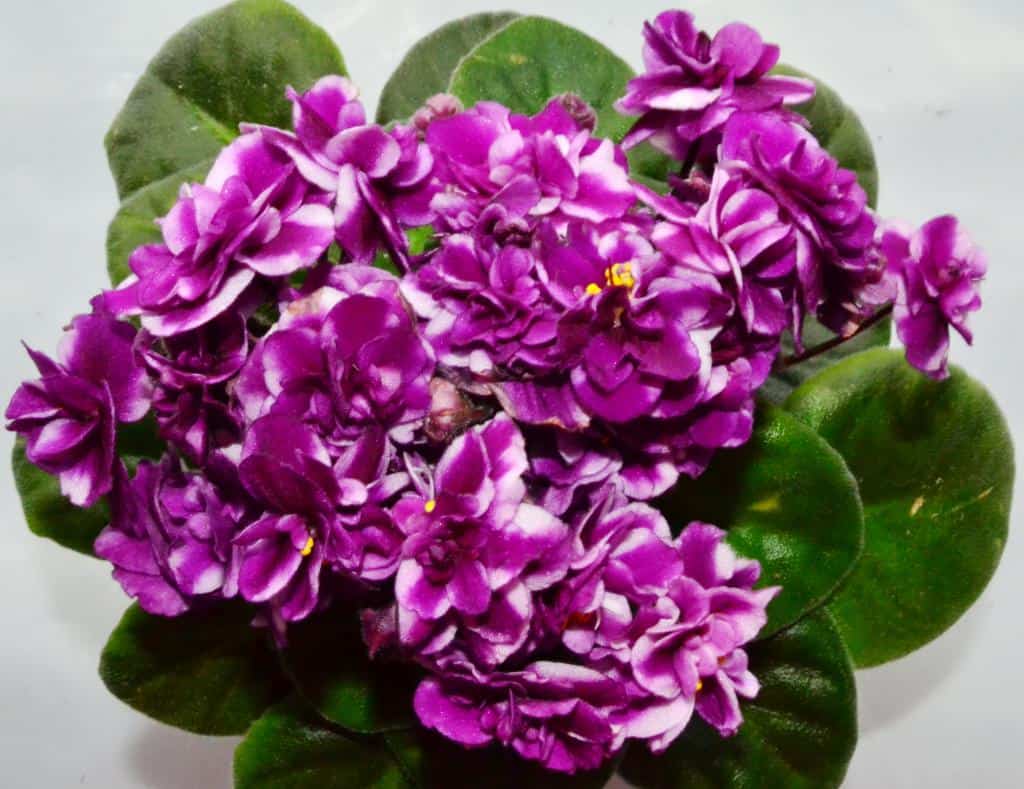

I mastered this procedure very quickly, and now time has no power over my violets!
What happens to a violet during development?
The most abundant flowering of Saintpaulia falls on first 2-3 years... Life growth of the lower layer of leaves is 1 year. After a year, the leaves lose their decorative effect, curl, wrinkle and either die off themselves, or are removed by the owner.
After 3 years, a bare green trunk remains from several tiers of lower leaves... After some time, the trunk of the plant stiffens, dressing in armor similar to the bark of a tree.
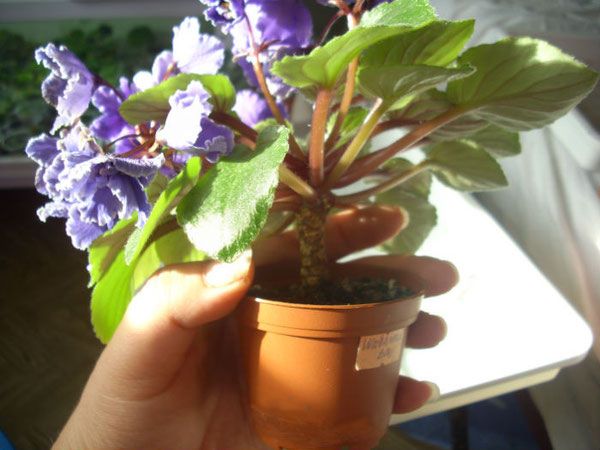

The trunk of an old violet.
Peduncles become smaller after 3 years, their legs become short and thin. Flowers lose their size, color and decorativeness. In general, the plant begins to give the impression of stunted, tired and sick.
Even if the grower regularly cares for the plant, feeds it and creates all kinds of favorable conditions, a plant, like any living creature, grows old and loses its charm. In this case, you should study well what to do with old violets.
Below are several ways to update indoor violets at home step by step with a photo.
Why do you need to update violets
Sooner or later, the violet begins to lose its decorative beauty. The leaves are thinning, the stem is bare, the buds appear less and less. If nothing is done, then every day the appearance of the plant will only worsen.
In addition, the bare stem negatively affects the well-being of the flower: the violet slows down its growth, its new leaves remain small, it seems to “fall asleep”.
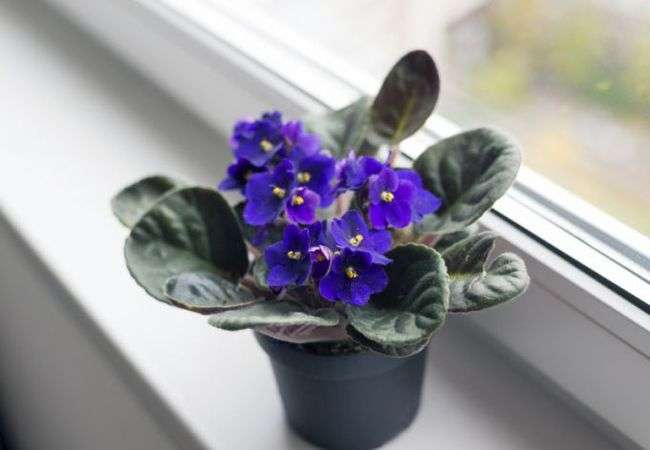

A regular transplant won't help here. Saintpaulia needs to be rejuvenated by removing all unnecessary things from it. Otherwise, the flower will die much earlier than it could survive with proper care.
How to rejuvenate a violet at home?
Violet rejuvenation at home can be done in several ways:
- adding soil;
- transplant with deepening of the bare trunk;
- rooting of the cut top.
What you may need during plant transplantation:
- light soil for Saintpaulias containing sphagnum, perlite, peat and charcoal;
- drainage:
- Styrofoam;
- expanded clay;
- sphagnum moss;
- perlite.
Is it possible to transplant flowering violets: process features
Can blooming violets be transplanted? Such decisive action is required if the flower begins to wilt.
Only experienced flower growers know how to transplant a violet at the time of flowering. It is precisely necessary to remove branches with buds, so the plant will stop flowering at the time of transplantation. But the principle of the procedure does not differ from the standard one.
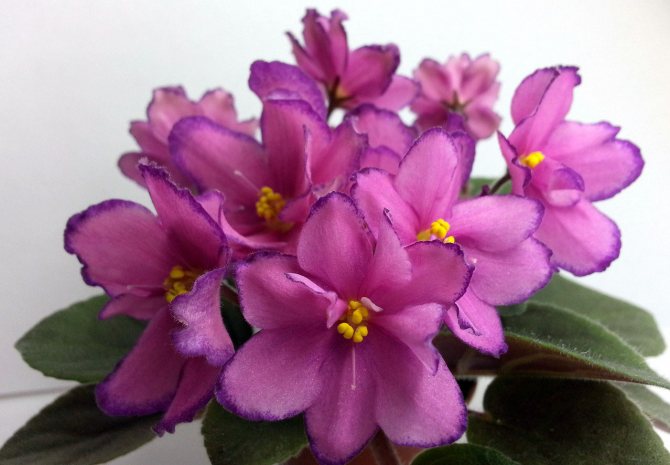

Transplanting a blooming violet
Indoor flower violet is considered a rather whimsical plant that requires special attention and care. Difficulties can arise, including in the process of transplanting a flower. This procedure is accompanied by a lot of nuances that are important. Transplanting is carried out in several basic stages associated with soil preparation, selection of a pot and further care.
Transplant nuances
Transplanting an old plant there are a few rules to remember:
Features of transplantation of young processes
You need to understand exactly how to plant a violet correctly, especially to separate the young sockets. The procedure has several features:
- It is impossible to completely remove the earthen lump from the root.
- It is advisable to first plant the shoot in a pot with a diameter of 3-4 cm.
- The substrate is used the same as for transplanting an adult specimen.
- Children must be covered with a plastic bag after planting.
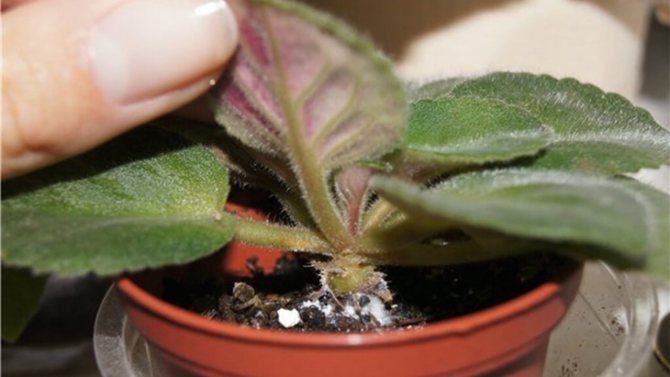

Transplant of a young appendix
When the young shoot outgrows the leaves of the edge of the pot, the container can be changed to a larger one.
If the violet has grown a lot: what to do, how to thin out?
A compact and neat bush of violets overcame gracefully and elegantly, and the overgrown violet hints at the need for its rejuvenation. For this it is necessary to prune the bush in a timely manner:
- extra leaves (the largest, damaged or lost turgor);
- stepchildren;
- faded peduncles.
If the violet has grown a lot in the pot, perhaps she needs a bigger pot: ideal diameter - 10 cm. It happens that several stepsons have grown from the main trunk, and the florist missed this moment. Stepsons need to be carefully cut off and put on rooting.
If the compact shape of the flower cannot be restored, it is recommended to cut off its crown, root it and form a new outlet as you wish.


Rooting the crown in water.
Rejuvenation methods
Be that as it may, if the violet is healthy, you should not immediately throw it away, because it is quite possible to return the flower to its previous appearance.This can be done in two ways, depending on how much the trunk is exposed:
- Transplant completely... If the violet does not stretch significantly, it just needs to be transplanted, but with one condition - when planting, the entire bare trunk should be deepened into the soil. Thus, new, additional, roots will grow on it, which will feed the upper part of the bush and after a while young leaves will form on it.
- Cut off and root the top... This method is used if the trunk is very exposed and elongated.
Picking
It happens that a box with seeds is formed on a faded peduncle (with self-pollination of Saintpaulia). In this case you can try sowing the seeds of the plant.
The ripening time of the seed box varies up to six months. The ripe (dried) seed pod is carefully cut off and allowed to lie down for a couple of weeks to ripen.
Ripe seeds are very small and dusty... Before sowing, they are mixed with charcoal powder or with sand for more even germination. The prepared seeds are placed on top of moistened soil, covered with a film and sent to a bright, warm place for a month.
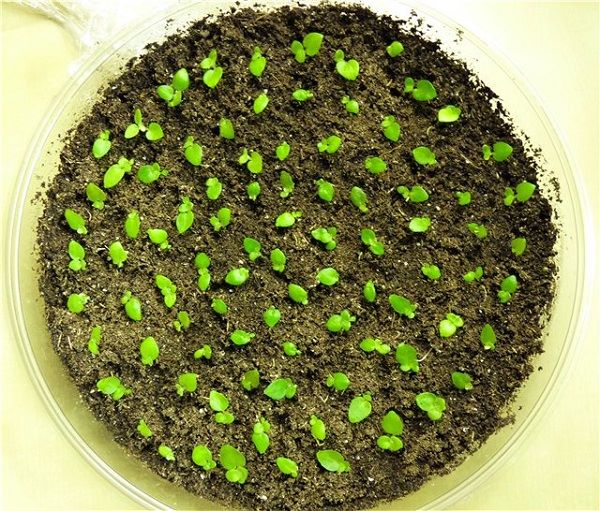

Shoots of violets from seeds.
After the first shoots appear, growers want to know if small shoots need to be thinned out. This must be done. When the seedlings reach ½ cm, the first dive is carried out.
A pick is the planting of Saintpaulia seedlings in a separate container in order to expand the area for good nutrition of the young plant. Also, dived plants will not have to crowd and fight for sunlight as they grow.
Seedling picking promotes the growth of the root system, and also hardens the seedlings.
Technology
What should be prepared before starting the procedure:
- the seedling tray itself;
- a toothpick or sharpened match;
- priming;
- seedling cassettes, preferably with a transparent lid;
- warm water;
- drainage.
How to dive Saintpaulia correctly:
- A drainage layer (polystyrene, expanded clay, sphagnum moss, perlite) is laid at the bottom of the containers (or a common tray), and soil is poured onto it. Special soil for Saintpaulias can be bought at the store, for greater looseness it can be combined with peat, sphagnum moss, perlite or vermiculite;
- The soil in the nursery is pre-moistened;
- With a match or a toothpick, the plant must be carefully picked out with a lump of earth, transferred to a new place, placed in a small depression and carefully dug in;
- The transplanted plants should be watered with warm water, covered and removed to a warm place away from direct sunlight.
The main methods of transplanting violets
Before planting violets, you should ask how and when you will need to start transplanting the plant. There are 2 main ways. The first one implies a complete replacement of the soil, and the second one - a partial one. Indicators of soil condition, the appearance of the flower and its development will help determine when and what transplantation of violets is required.
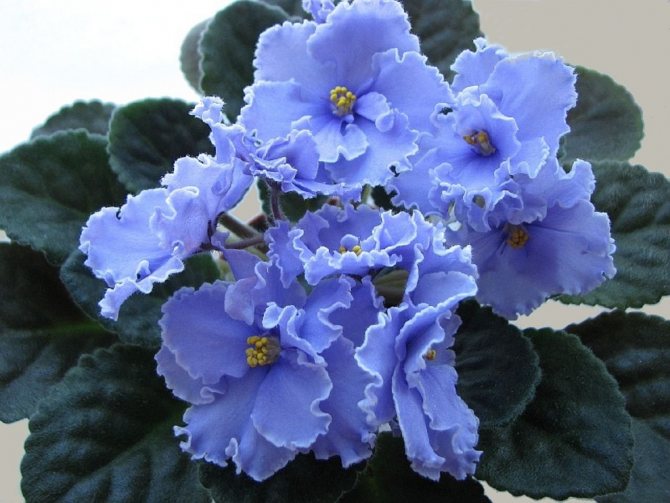

Violet planted in a flowerpot
Partial soil replacement
A partial transplant is necessary if the violet has managed to grow to a huge size - there is not enough space for the root system, it is too early to plant or there is no reason.
Algorithm of the procedure:
- Remove the seedling from the old container.
- Do not remove the earthy clod from the root system.
- Prepare a new pot with drainage and a layer of new soil at the bottom.
- Place the flower and sprinkle with the substrate on top.
Additional Information! In the process of partial replanting, you can divide the bush to breed the variety.
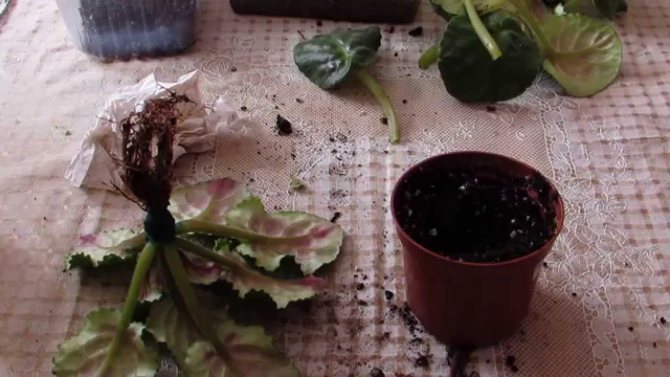

Partial soil replacement
Such a procedure will not disturb the root system, which means that the plant will experience less stress.
Complete soil replacement
Planting a specimen in a new soil is simply necessary if the old substrate begins to mold and sour.In this case, the leaves will begin to wither and turn yellow outwardly - the plant may die completely.
The procedure is carried out as follows:
- Remove the plant from the substrate.
- Shake off soil particles and cut the root, removing dry and rotten shoots.
- Break off lower moldings if they are yellow.
- Treat the sections with activated carbon powder.
- Place a drainage layer on the bottom of the pot. Sprinkle it with new soil.
- Place the sprout in the container and add so much soil so that it reaches the level of the lower sheets, partially covering the trunk.
Note! If, in the process of pruning the shoots, the root system has become smaller, then the container for planting must be taken of a smaller size.
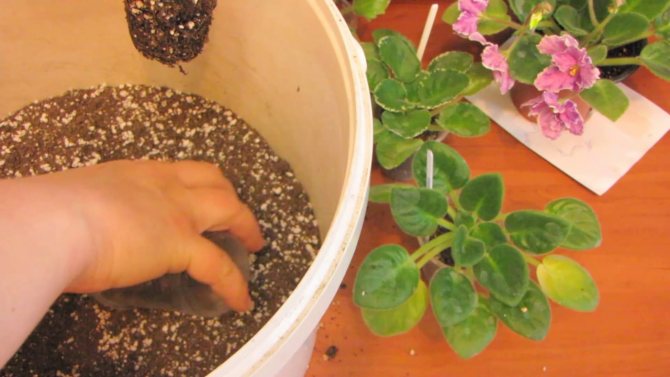

Complete soil replacement
After a day, watering is carried out and, if necessary, the substrate is added - the stem of the violet should be closed.
Tips from experienced florists
- if you want to buy violet seeds, it is better to buy them at a flower show from experienced collector-florists;
- do not transplant a tiny plant into a large container - it will die;
- soil, dishes and tools before transplanting a plant you need decontaminate;
- in an optimal microclimate (temperature not lower than 20 degrees C, constant soil moisture level), plants germinate better, are accepted and take root;
- water for irrigation shouldn't be cold;
- rejuvenating a violet is better in spring or autumn.
What to do with stepchildren?
The formation of stepchildren in violets far from uncommon... Stepsons are plants that form in the leaf axils. They take a lot of energy from the plant, spoil the appearance and delay flowering.
IMPORTANT! When transplanting, they must be removed. It is more convenient to do this with the help of such improvised tools as a toothpick, pencil or pen, by carefully breaking it out.
In the future, the broken off stepsons can root for breeding transplanted flowers. For rooting, stepchildren are taken with 3-4 pairs of leaves.
The reason for the formation of stepchildren is primarily too nutritious soil with a high nitrogen content. Another unpleasant reason for their appearance can be infection with diseases. The plant tries to survive by any means and leaves as many offspring as possible.
Signs of aging violets
The serious age of the violet can be determined by the following signs:
- blooms poorly;
- small flowers;
- curve socket;
- bare stem;
- problems with leaves: dark spots, unusual for the variety border on the edge of the leaf blade, twisted sluggish leaves even with sufficient watering;
- shrinking of the central leaves.
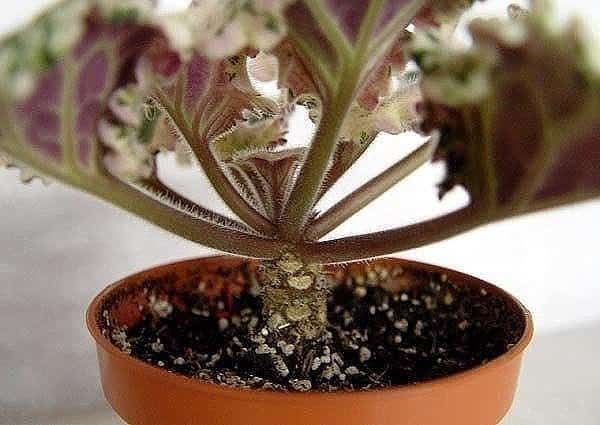

Sometimes the same signs can be observed even in young (2-3 years old) Saintpaulias. The reason for this early aging may be the soil.
Take a close look at the earthen ball in which the violet grows.
If you see that:
- there is a white coating on the surface of the substrate (precipitated salts contained in the water for irrigation);
- the soil is caked, i.e. there are no air sinuses, so necessary for the violet for breathing the root system;
- the chemical composition of the soil has changed - it has acidified from the "wrong" water;
- the root system is cramped in the container,
then the time has come for active actions to save the young, but already sick violet.
How to check the root system for diseases and pests?
A healthy root system is the key rapid development and growth... When transplanting Saintpaulia, it is imperative to inspect the roots for the presence of:
- Diseases;
- And pests.
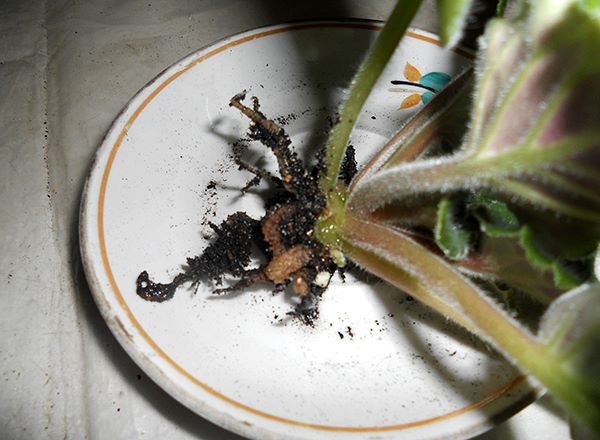

Check roots for pests and diseases before planting.
Healthy, non-infected roots must be:
- White;
- No signs of decay.
All black, brown, rotten and dry scions need to delete... If this is not done, then the stem of the flower itself will begin to rot, which will gradually lead to its death.
Saintpaulia rejuvenation methods
There are 3 ways to rejuvenate your favorite varieties of violets:
- Planting a leaf.
- Digging in the stem.
- "Head demolition" at the violet: re-rooting of the socket.
Rejuvenation by planting a leaf
This is the most common method of reproduction and rejuvenation of violets. To do this, cut off the petiole with a leaf blade with a sharp knife and put it in water so that the water does not touch the leaf. It is necessary to add a crushed activated carbon tablet to the water.
After 2-3 weeks, roots will appear at the edge of the petiole and the leaf, together with the resulting roots, can be transplanted into light soil.
You can do without an intermediate stage - soaking the leaf petiole in water. For this, the following manipulations are performed:
- dip the cut of the petiole into the root stimulator;
- cut the leaf by 1/3 (if the leaf blade is large)
- planted in a moist, nutritious light substrate;
- Cover the top with a cut plastic bottle or plastic bag to create a greenhouse effect. Once every 2-3 days, the greenhouse is slightly opened for ventilation.
Note! This method is practically trouble-free, however, you can get a new flowering plant no earlier than 2 years after the start of rooting.
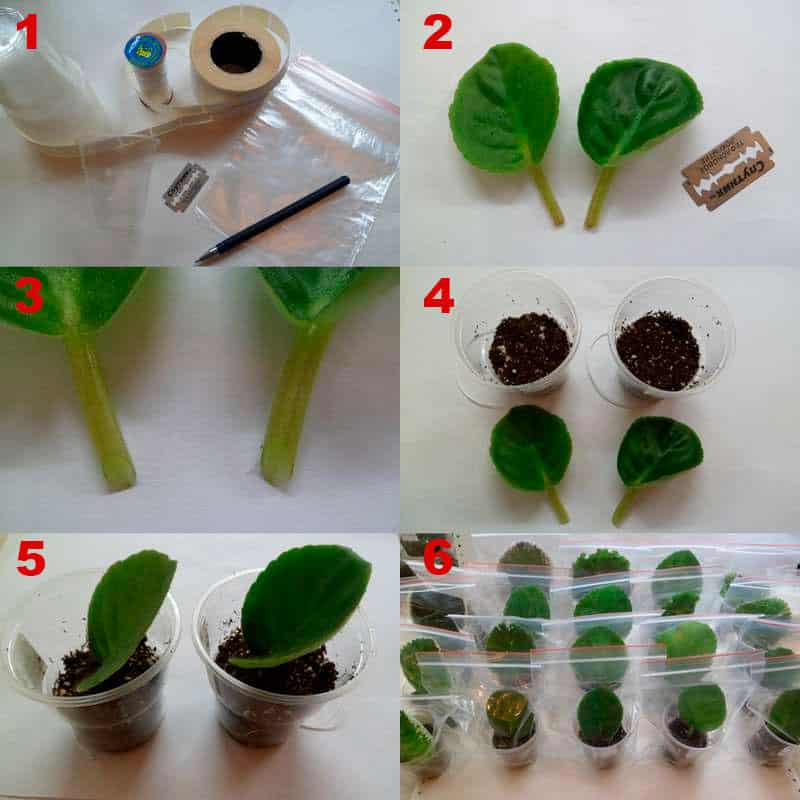

You can get a renewed plant much faster using other methods.
Digging in the stem of Saintpaulia
A peculiarity of the violet is that the roots are formed not only from a buried leaf, but also from a stem buried in the ground. Saintpaulias use this feature when the plant "sticks out" from the ground by no more than 1-2 cm. That is, the violet resembles a palm tree on a short trunk. But this trunk is quite viable: green, not overgrown with dead scales and cuttings from removed leaves.
- cut off (or break off by hand) the lowest layer of leaves;
- sprinkle the bare stem to the lower leaves with a layer of fertile soil or moss.
The rejuvenation process
The process of plant renewal itself does not take much time. If you do everything right, the flower will regain its decorative properties and will delight the eye.
Update Methods
There are several ways to rejuvenate indoor Saintpaulias at home:
- By cuttings. A leaf is taken from the main bush, placed in the water, and soon roots appear on it. The disadvantage of the method is that it is time-consuming, since it will take about 2 years to grow a new bush from a leaf.
- This method is suitable if the exposed part of the stem does not exceed 3 cm and is green in color. You can rejuvenate a violet by deepening the stem. This method is easier and more painless for the plant. Professionals advise to practice this method, and not wait until the violet grows strongly and more drastic measures are required.
- In relation to old Saintpaulias, in which the trunk has already become very coarse and turned brown, a different method is used. You need to root the cut off stem of the old violet in the water.
Step-by-step instruction
The first method is the most common. Many had to bring home leaves and sprout roots on them:
- A glass of warm water is needed, where crushed activated carbon is added for disinfection to exclude diseases of violets.
- A leaf is placed in a container (and preferably 2 or 3, since not all leaves germinate). After 1-2 weeks, the roots will appear. It is important to ensure that the stems do not rot.
- The stalk is placed in the ground no more than 1.5 cm.A month later, a new shoot will appear on it.
The main stages of the step-by-step instructions for rejuvenating violets in the second way are as follows:
- First, the plant, along with the root and soil, is removed from the pot.
- Extra lower leaves are removed from the trunk.
- Half a lump of earth is cut off with a sharp knife.
- In a new pot, drainage with a substrate is laid and the plant is placed there.
- An earthen lump around is filled with a substrate and covered with it from above.
- The transplanted flower is watered with water at room temperature, covered with half a plastic bottle or a transparent plastic bag on top.The main thing is to create a mini greenhouse for the flower.
After some time, the stem of the plant sprouts new roots that will nourish the flower.
How to upgrade a long stem violet?
This method is suitable for an old plant when the trunk is not able to give new roots:
- The violet is taken out together with the earth from the pot.
- The lower leaves must be removed, leaving no more than 6 leaves, since the plant will be weakened and at first it will not have the strength to feed many green leaves.
- With a knife, cut off the stem 3 cm below the beginning of the growth of the leaves, sprinkle it with activated carbon.
- The rough brown skin is gently scraped from the violet stem to a green surface, after which it is dried.
- With the cut off top, the flower is placed in water.
In a few days, the renewed old violet will take root. When they reach a length of about 2 cm, the violets are planted in an earthen mixture and a greenhouse is made using a transparent container.
Additional recommendations
The pot for transplanting violets must be selected in size or slightly larger, with a drainage hole in the bottom. The container must be laid with drainage material, the soil must be neutral. Water the plant with warm filtered water.
When updating violets, a new soil and a new container are used; florists do not advise mixing the old soil with the new one.
Following these recommendations and proper care will make the transplant as favorable for the plant as possible.
When can you carry out procedures for rejuvenating violets?
The optimal period for rejuvenation operations is a period of active growth of violets: spring and cool summer. At temperatures over 27 degrees and less than 15 degrees, rooting processes are less efficient.
For the fastest growing of the root system, it is recommended to water the seedling with root formation stimulants in accordance with the instructions for the preparation.
The period of budding and flowering is not the best for plant rejuvenation.
Remember! Each flower is a dependent, it takes away the strength from the violet, which, when rejuvenated, it must direct to survival.
For a flower to take root as soon as possible, active photosynthesis is necessary, since in the absence of roots the plant receives energy only through the leaves. Therefore, a long daylight hours are very important during the rooting period of the rosette. It can be provided with additional plant illumination with special phyto- or conventional fluorescent lamps.
When is the best time to rejuvenate a violet?
In addition to the main points, such as the flowering period, in which the plant is not transplanted or rejuvenated, there are more and less favorable days. This is due to the phases of the moon.
Violet transplant calendar for 2019
| Month | Favorable period for rooting non-varietal violets | Favorable period for rooting variegated and ampelous violets | Unwanted days for transplants and other manipulations |
| January | 1, 2, 24, 28, 29 | 3, 30, 31 | 5, 6, 7, 8, 9, 12, 13, 14, 21, 22 |
| February | 1, 21, 25, 28 | 26, 27 | 3, 4, 5, 9, 10, 18, 19, 20 |
| March | 23, 28, 29 | 25, 26, 27 | 3, 4, 5, 6, 8, 9, 13, 17, 18, 21, 22, 30, 31 |
| April | 2, 3, 20, 24, 25, 26, 29, 30 | 22, 23 | 1, 4, 5, 6, 12, 13, 14, 15, 19, 21, 27, 28 |
| May | 1, 21, 22, 23, 27, 28, 31 | not | 2, 3, 4, 5, 11, 12, 19, 20, 24, 25, 29, 30 |
| June | 18, 24 | 30 | 2, 3, 7, 8, 17, 19, 20, 21, 22, 25, 26, 27 |
| July | 21, 25, 26, 30 | 27, 28, 29 | 2, 4, 5, 10, 16, 17, 18, 19, 23, 24 |
| August | 16, 18, 21, 22, 27 | 24, 25 | 1, 2, 14, 15, 17, 19, 20, 28, 29, 30 |
| September | 18, 19, 22, 23, 24 | 20, 21 | 7, 10, 11, 12, 14, 15, 16, 17, 25, 26, 28 |
| October | 15, 16, 21 | 17, 18, 19 | 6, 7, 8, 9, 12, 13, 14, 22, 23, 27, 28 |
| November | 16, 17, 20 | 13, 14, 15 | 4, 5, 9, 10, 12, 18, 19, 25, 26 |
| December | 13, 17, 19, 23 | not | 1, 2, 6, 7, 12, 15, 16, 25, 26, 28, 29, 30 |
How to slow down the aging of violets?
The inevitable aging process can be significantly slowed down if you follow the Saintpaulia transplant schedule.
How often should a violet be repotted?
It depends on the watering method:
- if top watering or watering through a pallet is used in the care of a violet, then it is enough to replant once a year, in the period March-April;
- if wick irrigation is used, then the frequency of transplantation should be higher - every six months.
The container into which the violet is transplanted should be no more than 1 cm wider in diameter than the rosette of leaves.
When transplanting, it is recommended to completely change the soil without using the old substrate.
This schedule can be changed if the deterioration of the soil condition is noticeable: salt deposits, caking. In this case, the transplant and rejuvenation is carried out earlier than the scheduled date.
How to prepare soil for transplanting violets yourself
After determining how to plant the violet correctly, it is worth preparing the substrate.If you wish, you can do it yourself. You just need to know what kind of soil to use.
Fertile soil for violets - do it yourself:
- sod soil;
- humus from spruce needles and leaves;
- perlite;
- river sand;
- peat.
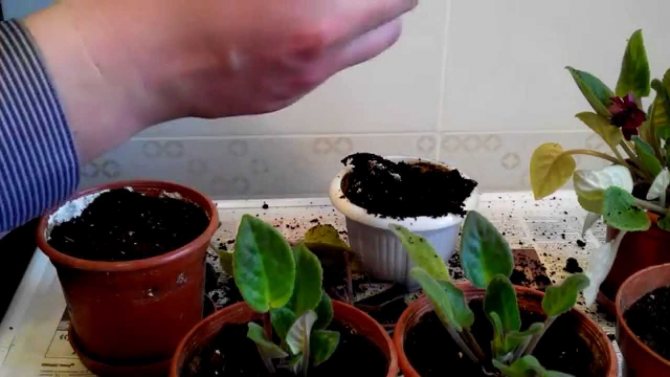

Soil preparation
To avoid the appearance of insects in a homemade substrate, you need to carefully sift all the components.
Taste and color
Violet is a subtle mood harmonizer, in its presence even shy people feel more confident. The velvety leaves of Saintpaulia resemble hearts, therefore it is considered capable of connecting the hearts of lovers.
And some feng shui masters attribute the violet to the ability to influence the flow of money into the house. Upon closer acquaintance with the influence of Saintpaulia on space, the following became clear:
- White violet is set up to resist negative emotions, and it is suitable for owners with an unstable nervous system, prone to sudden mood swings. This flower is suitable for a children's room, and also ants do not like it.
- The violet Uzambar violet adjusts its owner to the development of the spirit, and this occupation involves removal from the hustle and bustle and some disconnection from reality. Such a mood does not coincide with an intense work schedule, so the plant does not harmonize with the office. But in the house, a purple flower can create an aura of peace and quiet, but in a nursery it is not very appropriate. Suitable for people who are fond of meditation, working with dreams and other practices that require deep immersion in the subconscious.
- The blue Saintpaulia will not allow its owner to be bored or idle, and will definitely direct his attention to various sides of the world around him, where there is an opportunity to reveal his potential. This flower is simply created for the desktop, at which a schoolchild or student is engaged, and can also have a beneficial effect on the creative atmosphere in the studio.
- Violets of red or pink shades can help increase the level of optimism. And if you have made the decision to change your eating habits, hoping to lose weight, then this color will support you in this endeavor, giving stamina and perseverance. And also these flowers expand the spectrum of perception of the world from black and white to multi-colored, and also help to enhance concentration of attention.
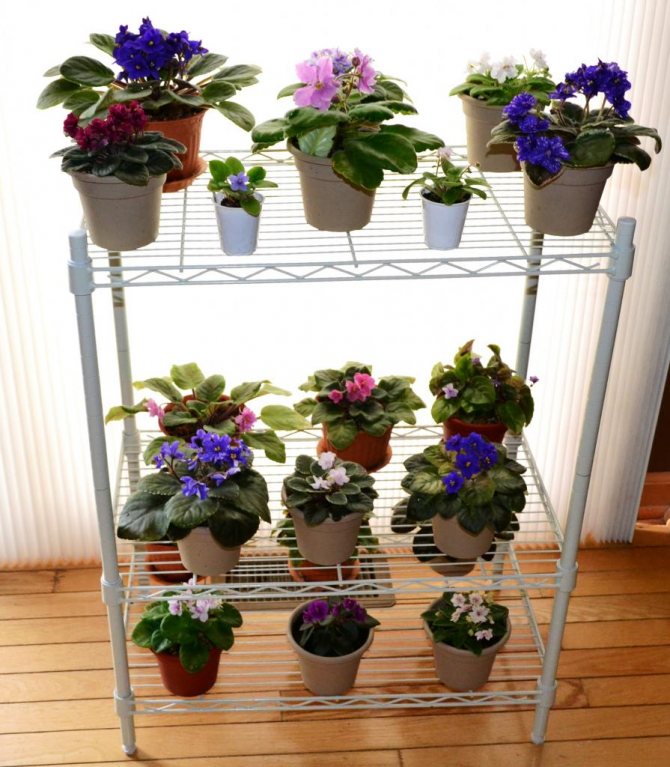

Having considered the advantages of violets with different shades of colors, you can advise to get several of these colors, placing them either in one place or in different rooms.
How to seat the "kids" Saintpauli
Novice violet growers can't wait to start planting at the sight of a friendly growth that has appeared. But hurrying can seriously harm. Wait for the "kids" to acquire two or three pairs of leaves.
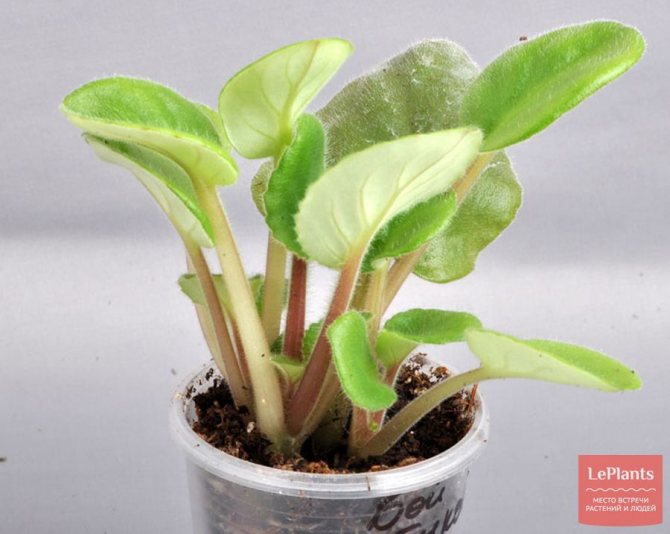

ON THE PICTURE: Such "kids" can be seated.
How to deal with white "kids"
Variegated varieties often have chlorophyll-free offspring. Its white leaves are completely devoid of green fragments. This is normal. Colorless "babies" can reach a decent size, but in no case should they be removed.
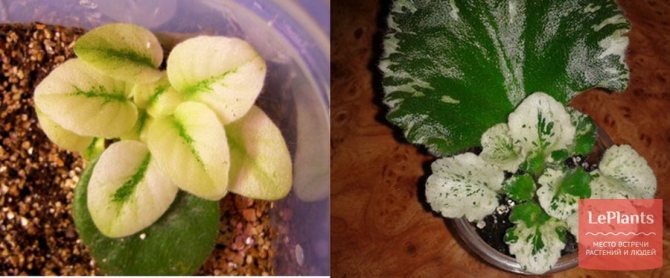

ON THE PICTURE: It would seem that it's time to start seating, the size allows. But a small amount of chlorophyll in the leaves will not leave the "kids" a chance to survive on their own.
The processes located at the mother leaf are completely dependent on it and receive nutrition at its expense. If you plant a white "baby", it will die very quickly: in the absence of chlorophyll in the foliage, the process of photosynthesis does not occur. Be sure to wait until the leaves with green fragments begin to grow in the colorless "children", and only then plant them.
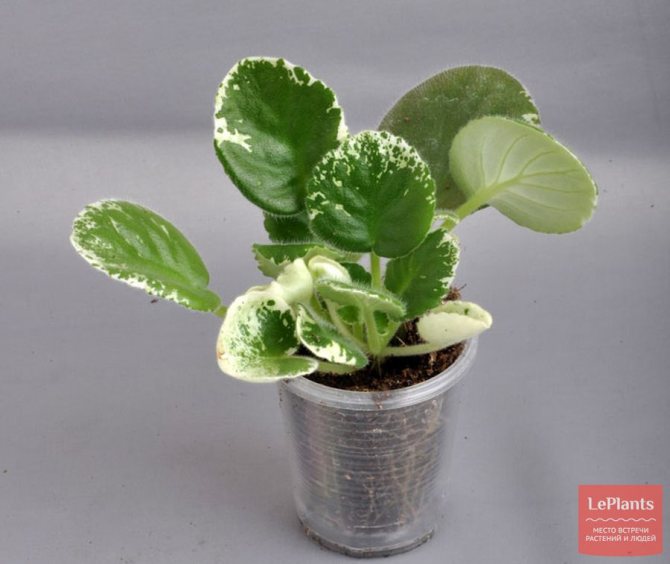

ON THE PICTURE: The variegated "children" in the photo have green leaves, they are healthy and strong. It's time to define an independent life!
Preparing for seating
It is best to place the "kids" in disposable plastic cups with a volume of 80-100 ml, preferably transparent.So it is more convenient to observe the development of the root system.
For each "kid" you need to prepare a separate glass. In order for the plant to form a beautiful even rosette in the future, each specimen must grow in a separate container. Drainage holes should be made at the bottom of the container to remove excess moisture when watering.
The earthen mixture is taken the same as for rooting cuttings: light, airy, moisture-permeable, based on high-moor peat.
Seating technology
1. We take out the mother's sheet with the "children" from the cup. Shake off the soil as much as possible. Holding the sheet with one hand, we take the "kids" into the other. We begin to slowly swing and pull them, separating them from the sheet.
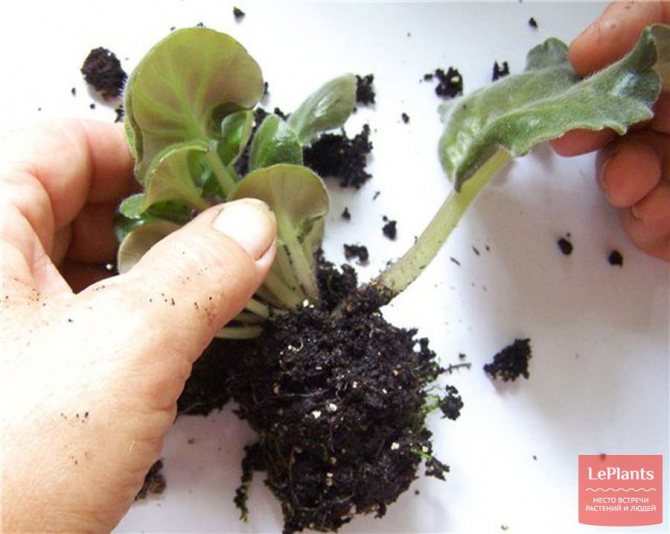

ON THE PICTURE: Separation of "children" from the mother's sheet.
2. In turn, we separate the "kids" from the common heap. Take your time: while disassembling, hold them with your fingers at the bases of the trunks, closer to the roots. As a rule, the leaves of "babies" are intertwined with each other. Unravel them carefully.
3. We examine the root system of the disassembled "children", clean it from the remnants of the torn off roots.
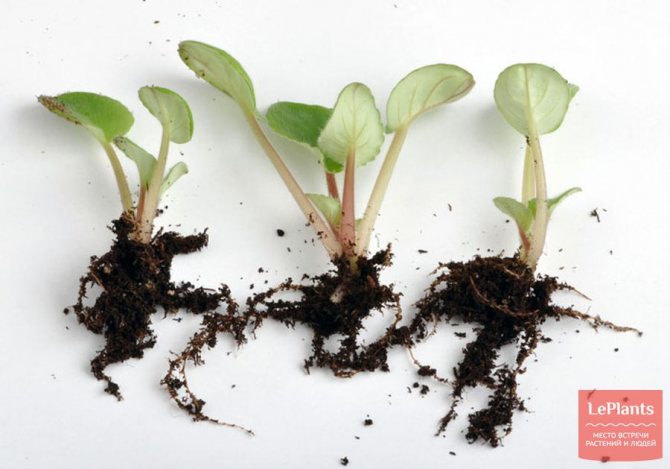

ON THE PICTURE: Disassembled "kids".
4. We seat the "kids" in prepared containers with drainage and filled up soil. It is important to plant strictly in the center.: This will make it easier to transplant the young plant into a permanent pot later on.
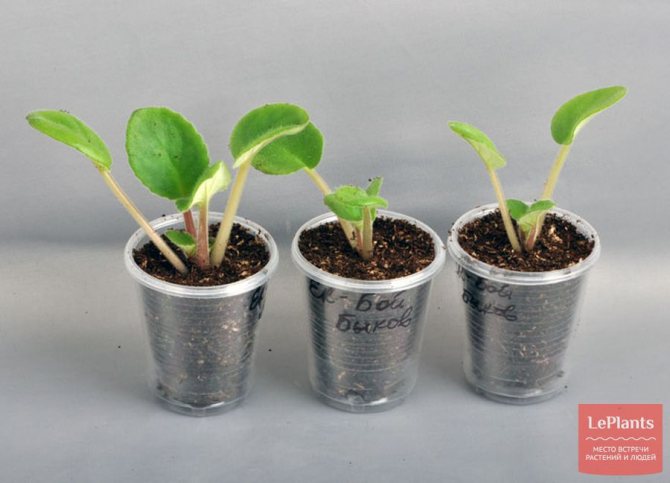

ON THE PICTURE: "Children" of the uzambar violets were transplanted into individual cups.
Sometimes it happens that when parsing "children" partially or even completely lose their roots. Do not be discouraged and, moreover, do not rush to throw them away. The root system of Saintpaulias recovers very quickly. It is better to put "kids" in wet sphagnum or, if available, in a peat-humus tablet Jiffi-7.
5. We put the "kids" in the greenhouse, not forgetting to ventilate them. After a few days, you can remove the lid and start watering the plants a little at a time.
Seating a large number of "kids"
On a healthy, strong leaf, from three to five "offspring" can form. They grow the same way, so they sit down at the same time.
Some varieties of violets are particularly fertile. They form up to eight or twelve “babies” on a leaf, but such offspring are small in size and grow up reluctantly. In this case, they are carefully separated from the parent plant by the whole “family”, which is divided into several groups, depending on the number of “children”.
Each group is seated in a separate glass. In such a "kindergarten", kids easily take root and grow up quickly. When an acceptable size is reached, they are seated one at a time.
It happens that the "baby" significantly outstrips the neighbors in growth, looks like Gulliver next to them among the midgets. It must be planted individually, without waiting for the rest to grow up. The "accelerated baby" gets all its nourishment from the mother's leaf, while others do not get anything to grow.
Technology of separation and landing of a large "baby"
1. We take out the leaf with the “kids” from the cup and, holding it with one hand by the handle near the roots, with the other hand, we begin, gently swinging, to pull the desired “baby” out of the common pile. With others, they do the same, leaving only the undersized at the leaf.
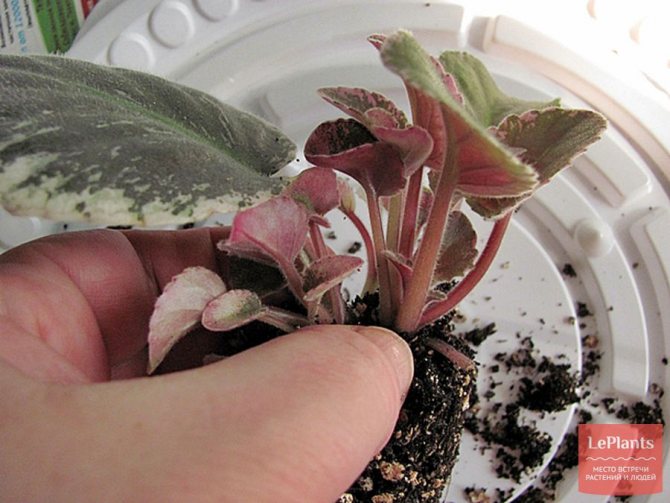

ON THE PICTURE: The largest "kids" should be set aside, without waiting for those lagging behind in growth to grow up.
2. We put the sheet with the remaining "kids" in the old place and add some soil.
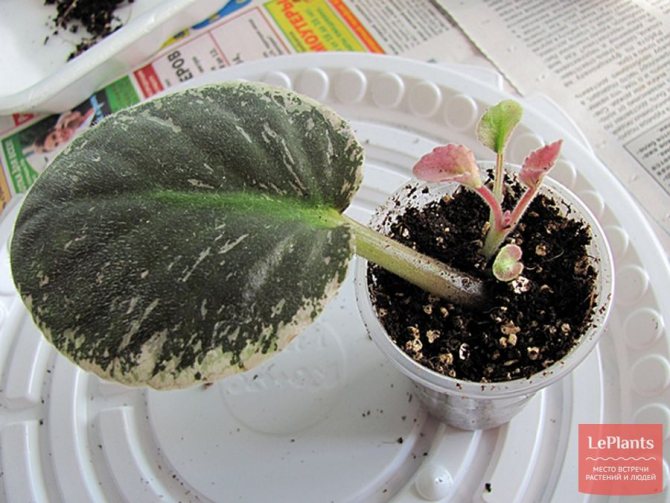

ON THE PICTURE: "Babies" left for growing.
How to care for the seated "children" of Saintpauli in the future, read in the publication: "Uzambara violet: the first steps."
How to seat the kids
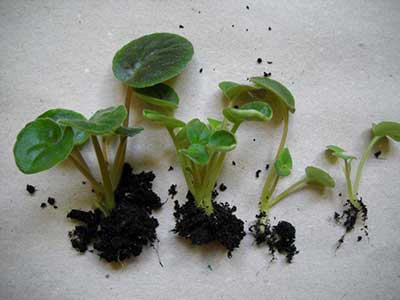

When the children have formed at least two pairs of leaves, they begin to separate them from the leaf blade of the mother flower.
Using 100 ml plastic cups, the soil is prepared from peat, vermiculite and chopped sphagnum.
The leaf with the children is removed from the container, the children are separated, which are fully formed bushes. Plants are planted in cups, but the growth point is not deeply deepened.Moisten the substrate, place containers under the lamp. When the bushes take root, they begin to transplant into large containers.
How to make a pot for violets with your own hands
For those who like to craft something themselves, as well as for those who, for one reason or another, do not want to buy a container in stores, we will tell you a simple way to make a pot for Saintpaulia with your own hands.
Did you know? The violet is not only a beautiful but also a useful flower.
—
releasing phytoncides into the air, it kills pathogenic bacteria.
For this you will need:
- Scissors.
- Stationery knife.
- Marker (felt-tip pen).
- Stapler.
- Ruler.
- Sour cream plastic cup.


Procedure:
- Use a utility knife to clean the outside of the cup. Sticky labels can be easily removed, and the printed lettering is gently scraped off. The result should be a completely white container.
- Using a ruler, measure 6 cm from the bottom of the glass and mark with an even strip along the outer circumference with a marker. It will sort of divide the container into two halves.
- Cut the glass with a knife along the strip, then cut it in two with scissors.
- Cut the upper cut off the annular part with scissors, as if breaking the ring.
- Insert the cut part inside into the remaining cup until it stops. The edges of the "ring" inside the cup will fit into a small "overlap". Mark the size of the "overlap" and, removing the annular part from the container, cut off the excess.
- For control, put the "half ring" in the cup - the workpiece should lie flat.
- Fasten the structure with a stapler. Bonding nuances: staples with sharp edges inside the cup; fasten the first bracket on the side of the glass opposite to the cut, the second and third brackets - to the left and right of the cut. The result is a durable pot that you can take with your hands without fear of crushing it.
- Make a drainage hole in the bottom of the pot.
- Remove traces of the marker with a damp cloth.
The life of such a pot is about six months.
Learn how to make DIY violet soil.
How to determine if a flower needs a transplant
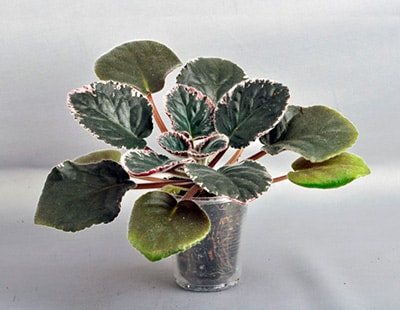

The violet needs a yearly transplant. If you neglect the rule, it will stop blooming, the leaves will stretch out and grind.
The urgency of the transplant is determined by appearance:
- leaf blades changed color from green to brown;
- the trunk stretched out and was bared;
- the soil in the pot has compacted;
- a white coating appeared on the surface of the soil;
- the roots are completely entwined with an earthen lump.
Saintpaulias quickly grow roots and carry nutrients out of the soil. There is no need to wait until the rosette loses its appearance, and the leaves stretch out - they make planned transplants.
First signs
It should be borne in mind that the violet needs to change the soil every six months, but taking into account the speed of its growth: when you see that the plant is cramped in the pot, then the time to "move to a new house" has come.
- If you notice that the substrate in the pot is covered with a crust of white mineral bloom, then this is another reason for transplanting violets.
- When the plant has acquired many children who are cramped in the flowerpot, it means it's time to prepare for their separation.
- If the leaves have lost their elasticity, they begin to fall off, there are few or no flowers, and the roots in the soil are intertwined in a lump - this is also a signal for the necessary manipulations.
- And if you notice uninvited guests-parasites in the pot, then you cannot hesitate in any case, even if the season is not suitable.
Possible problems


Rotting flower... After transplanting violets, some growers notice that the plant has begun an active process of decay. This could be due to:- The presence of parasites in the soil, poor soil quality.
Damage to the plant during transplantation.
- Excessive watering.
- Leaves turn yellow and dry... It would seem that after transplanting the violet in the new soil should become more beautiful and healthier, but light or yellow spots begin to appear on the leaves, or the leaves begin to dry out. The reasons may be:
- Incorrectly selected soil.
Inappropriate pot location.
- Failure to comply with the watering regime after transplanting.
- Does not bloom... The reasons for this problem:
- Too large crockery was selected during transfer.
- The soil is incorrectly selected.
- The transplant was carried out in the winter.
- Damage to the measles system.
In this case, the treatment must be urgent and cardinal: all damaged parts must be removed, and the violet must be rooted with a healthy leaf.
In the first case, transplanting into the "correct" soil will help, in the second and third - following the rules of caring for the plant.
Prompt elimination of the causes will lead to the long-awaited formation of buds.
The violet is one of the most charming and popular house flowers. Thanks to breeders, the list of new species of this beauty is constantly growing. Most of them are quite easy to grow and novice gardeners. But first, you should familiarize yourself with all the rules of care, reproduction, as well as diseases and pests that can prevent you from growing a healthy and beautiful plant.
We plant young violets


In the process of rejuvenating an adult bush, you can root some of the cut leaves. Approximately 2.5 months after rooting, they should be planted in separate cups, in which they will remain until their first flowering.
Once the young violets have bloomed, they can be planted in plastic or ceramic flower pots of the appropriate size. Regardless of the size and age of the violet, she needs to provide the necessary lighting, proper watering and a suitable temperature regime.
If you prepare well for the transplant process, then it will not cause you any difficulties. Over time, you will adapt, and you will do it quickly and accurately, since violets need to be transplanted quite often, and given the beauty of these plants, their number in your home will constantly grow.
Nutrient substrate composition
In flower shops you can buy a special mixture for violets. It includes the necessary minerals and biohumates. Sometimes the substrate is prepared on its own using the following ingredients:
- leafy land;
- peat;
- coniferous soil;
- sod land;
- river sand.
The required proportions are 2: 1: 1: 1: 1. To improve drainage, it is best to add a handful of crushed or fine charcoal.
The soil must be treated to remove fungus, bacteria and pest larvae. The best option is to bake in the oven for 20-30 minutes at a temperature of +200 ° C. If the oven is inconvenient to use, it is necessary to treat the soil with boiling water.


Bringing peace
According to garden feng shui, a plant with a certain energy corresponds to every corner of the house. Moreover, in order to acquire a specific shade, an individual flower needs to select rooms for different purposes. This also applies to the violet, which as a whole brings harmony to the space, however, the color of this quiet one should be taken into account.
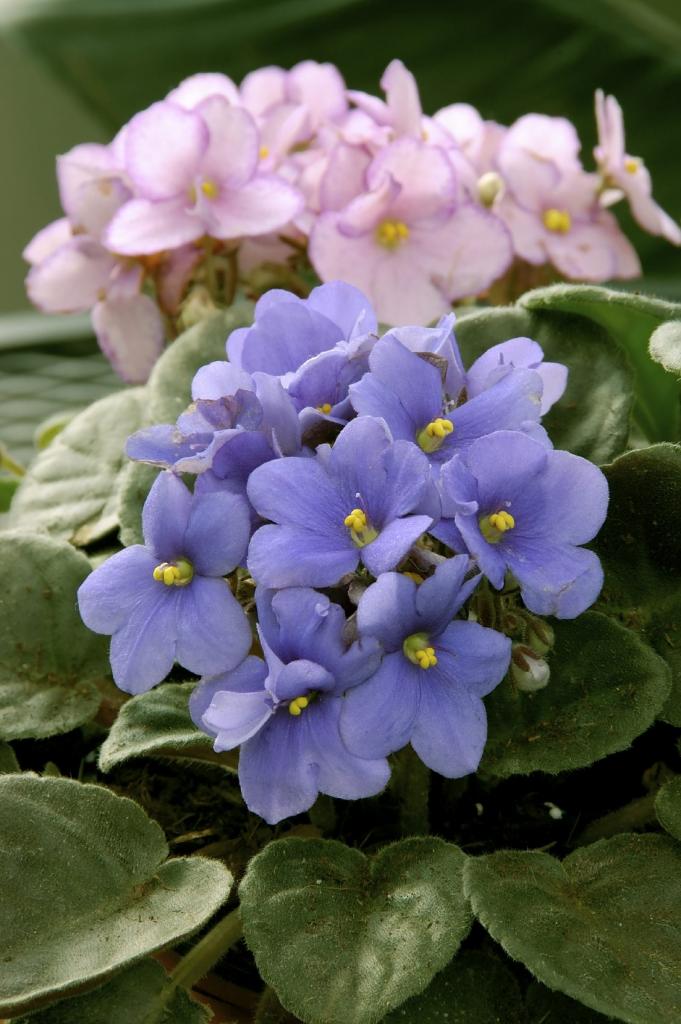

For example, the traditional Saintpaulia, also called the Usambara violet, has white, blue, red and traditional purple varieties of color. And there are also various variations of the basic shades.
So, white color creates an atmosphere of purity and serenity; blue adjusts to a romantic mood; blue - promotes the disclosure of creativity; purple color speaks of spirituality, which is why it is so often present in the robes of church hierarchs.
Favorable days for transplantation according to the lunar calendar
Some growers are planning moon phase transplants:
- In the waxing moon phase. All young plants are actively starting to grow, but the roots may not have time to provide nutrients to the ground part. When transplanting, they monitor soil moisture and make additional fertilizing;
- During the waning moon. The roots begin to grow, but the development of leaves and stems slows down. Such a period is favorable for violets - they almost always take root, master an earthen lump, and securely fix in a container. Watering is minimized, organic fertilizing is introduced;
- In the new moon and full moon, they refuse to transplant. Perennials do not take root well, and eventually die.
Post-transplant care
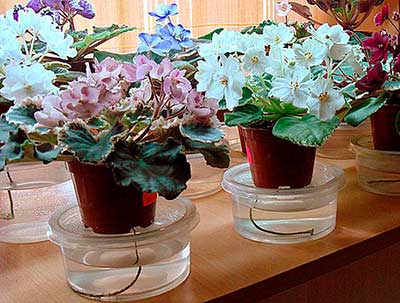

After transplanting into a large container, they provide optimal temperature indicators, substrate moisture, moderate lighting.
Correct care:
- Place the violet in a plastic bag. When condensation occurs, the film is removed for a few minutes for airing;
- Keep in a warm place with a temperature of 24 ° C;
- Protect from sunlight.
They adhere to a sparing regimen for at least two weeks. When the plant begins to develop, it is transferred to a lighted windowsill, but not under the scorching rays of the sun.
What pots should you plant violets in
Flower pots for violets, due to the peculiarities of the flower itself, must meet certain requirements, the observance of which will have a beneficial effect on its development in the future.
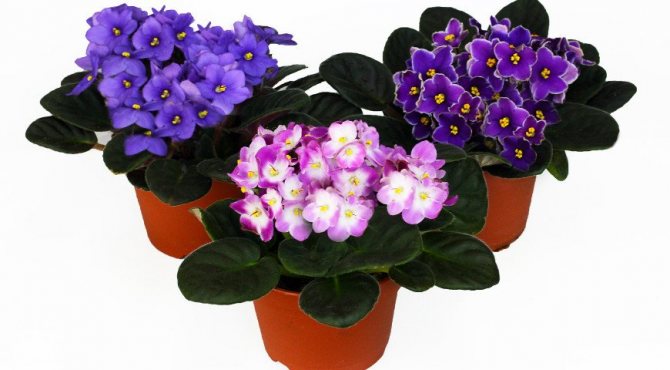

Consider the key requirements for capacity for saintpaulias:
- The pot should not be large. The violet itself is a compact, small flower and, accordingly, it does not require a large capacity.
- The pot should be squat. This shape of the container is determined by the peculiarity of the root system of the plant. The roots of violets do not grow in depth, but, on the contrary, tend outward. With the growth of the flower, the roots die from below, new ones grow instead. The root system is permanently located on the surface - so water and nutrients are more easily absorbed.
Transplanting Saintpaulia using the transshipment method
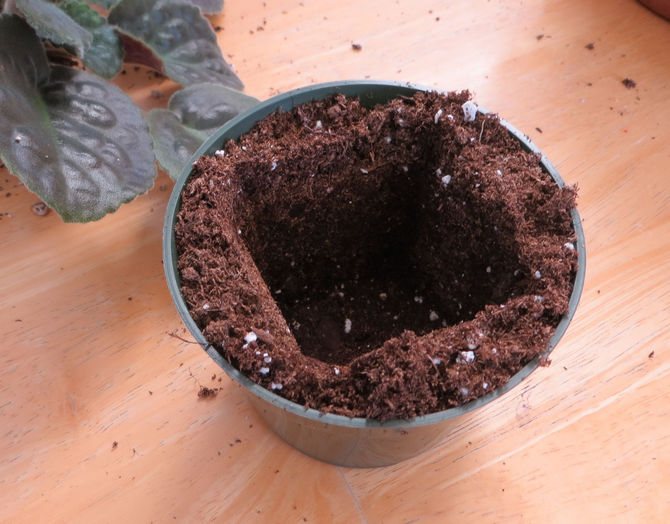

The transshipment method is used for transplanting violets during illness, as well as with a densely overgrown outlet. This flower transplant implies the complete preservation of the old earthen coma. Fill the new flowerpot with a good layer of drainage, then add some fresh soil. Insert the old one into the new pot in the very center. We fill the space between the containers with soil, tapping on the walls for better compaction. After that, we take out the old container and plant a violet in its place along with an earthen lump. In this case, the surfaces of the new and old earth should be at the same level.
Subject to all the rules of care, the violet will certainly delight with its exuberant flowering.
Plant transplant
Capacity requirements
Violets don't need deep pots. Their root system expands upward, so the maximum depth of the container is 10 cm.As for the diameter, depending on the age and size of the flower, it is necessary to purchase a container of 5-9 cm.For miniature varieties, a container with a depth of 5 cm and a diameter of 4 cm will be sufficient.
Particular attention should be paid to the material of the container. The most common options are:
- Plastic. Inexpensive and easy-to-use material. The light weight allows the pots to be placed on glass shelves or fragile window sills. In stores you can find a wide variety of shapes and colors, patterns, textures. The only drawback is the lack of ventilation. If the manufacturer does not provide openings for air and drainage in the container, they must be made using a highly heated nail. It is best to purchase a special container for violets. Such models are equipped with a convenient drainage system.
- Clay. Clay containers are quite heavy and bulky, so they are not suitable for fragile pots and glass racks. On the other hand, they retain heat well, retain water at the roots and allow the necessary amount of air to pass through. Such a pot can be purchased if the buyer's budget is not limited.
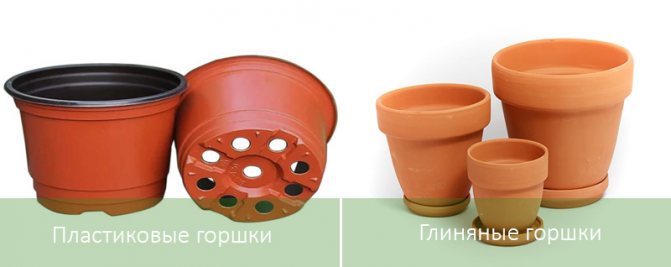

Convenient if the container is transparent. The owner will be able to control the size of the root system and transplant in a timely manner.
What to look for when choosing a pot?
You need to understand what pots are needed for violets, otherwise there is a possibility of buying an unsuitable container. Growing up in an uncomfortable flowerpot, the culture can start to hurt and stop blooming. There is even a risk of death. The most important parameters when choosing a container are its size and material of manufacture. You can read the article: Garden and home gerbera flower - recommendations for growing.
The size and size of the container
First you need to decide on the value. The roots of Saintpaulia do not grow in depth, but along the surface of an earthen coma. Even in nature, the roots do not go deep into the soil. This is due to the proximity to nutrients, air and light. Therefore, the culture does not need a deep capacity.
When choosing the size of a violet pot, it is important to consider the size of the plant. For example, a container with a height of 9 centimeters is suitable for an adult large flower. In this case, the diameter of the pot should always be equal to the height, that is, it should also be 9 centimeters. It happens that a flower grows so much that it ceases to fit in such a flowerpot. But you should not look for a larger container. It is enough just to shake off some of the soil and transplant the culture into a container of the same size. Larger varieties can kill the plant.
But when growing medium-sized plants, it is better to give preference to a container of 7x7 centimeters. Ideal will be pots for mini-violets or young Saintpaulias, the diameter and height of which are equal to 5 centimeters.
If you plant violets in large pots, then they will grow vigorously leaves. But there will be very few flowers. You should not expect flowering within two years. In addition, the soil, which is not entwined by the roots, turns sour and deteriorates. Various insect pests begin to grow in it, and fungal infections develop. In this case, it is often necessary to destroy the culture. A spacious container is justified only in the case of growing a mother saintpaulia for further seedlings and selection.
An ideal pot should be three times smaller than the diameter of a Saintpaulia rosette. Only in such cramped conditions will a violet feel comfortable. So, it will delight you with beautiful flowers.
Container material
When the volume of the pot is selected, it is determined with the material. On the shelves of the store, there is a wide selection of products made using different raw materials. They differ not only in appearance, but also have different effects on the plant.
The following options are commonly used:
- Ceramics. There are ceramic pots doused with glaze and not drenched. The first ones look much prettier. However, they do not let air in. And it is almost impossible to punch a hole. As for the non-drenched options, over time their appearance deteriorates, the color changes, drips of fluids and the intake of salts become noticeable. Quite often the vase falls apart in parts. Although it is in ceramics that Saintpaulia develops and blooms best. Since the pottery is heavy, it is important to choose a location for the plant. A thin glass shelf will not work in this case.
- Plastic. The advantages of such a container include lightness, durability and simplicity. He's pretty flexible. Therefore, the transshipment procedure is easier. But plastic does not allow air to pass through at all. And this is a disadvantage for the development of a good root system. This problem can be easily solved by making drain holes. So the roots will not rot, the soil will not turn sour.
- Plastic. On store shelves, you can see multi-colored plastic pots for violets that look very bright and pretty. Aesthetically, they are, of course, good. But you shouldn't choose them. After all, aniline mixtures are often used for painting them. And they tend to poison the root zone of the plant.
- Clay. These violet flower pots are considered a good choice. In a clay pot, the culture grows remarkably, pleases with lush flowering.This is due to the fact that the container is made of natural material, it is good for moisture and air. Thanks to this, the root system does not rot. The culture is much less likely to be attacked by pests and various kinds of ailments. True, clay pots for violets cannot be called durable. They break down pretty quickly. They need to be carefully looked after, washed and boiled. Clay containers are heavy. Therefore, it is not recommended to put it on fragile shelves, glass racks. Also, the clay container gets very hot in the sun. And this leads to the rapid drying up of the earth. Therefore, the violet needs more frequent watering.
Experienced gardeners claim that the best Saintpaulia pots are those made from plastic or clay. Sometimes, transparent plastic cups and cut bottles are used to grow Saintpaulias. Such containers look very unattractive. For camouflage, beautiful larger pots are used.
Mister Summer Resident warns: mistakes when transplanting violets
The violet can die if transplanted incorrectly. Florists often make the following mistakes:
- transplanting into a pot with a diameter of more than 9 cm;
- watering after planting in the center of the outlet;
- too deep or shallow location (leads to rotting of the roots and to a weakening of the rosette, respectively);
- the use of non-sterilized soil contaminated with fungal spores or bacteria;
- wrong choice of substrate components;
- the use of a soil mixture with an excess of nutrients.
The transplanting algorithm is simple, even a beginner in the field of floriculture can correctly perform it. The main thing is to find the right time to change the container and not forget about the nutrient substrate.
Is it possible to transplant a violet that blooms
But to the question of whether it is possible to transplant a violet that blooms, the answer is unequivocal - no. Starting from the time of the appearance of the buds and until the complete disappearance of the color, the plant is unsuitable for transplanting, unless, of course, there is a desire to lose all the color. And if the violet blooms, this is an indicator that in such conditions it is good and everything is enough.
An emergency for transplanting a plant covered with flowers is the appearance of parasites or too acidic soil in the pot. In this case, the violet is transplanted by the transshipment method, and the flowers are cut off so that the plant has the strength to take root.
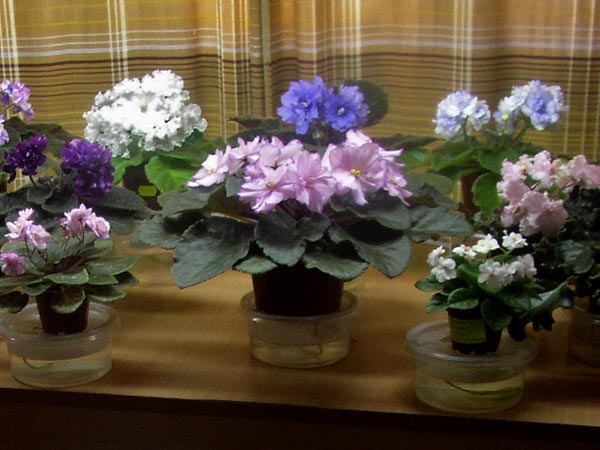

Terms of transplanting room violets
The pot needs to be changed in spring, April or May. It is also allowed to carry out the procedure in late February, early March or during the fall. At this time, the air temperature is optimal, and the daylight hours are quite long. It is strictly forbidden to disturb the plant in summer. In conditions of strong heating and low humidity of the soil and air, the violet can take root badly and die.
Winter transplantation is allowed, but only if phytolamps are used. They should extend daylight hours, especially in December. With a lack of lighting, the flower will take root just as badly as at elevated temperatures. In February, supplementary lighting is practically not required if the florist does not live in the northern regions.
Do not repot the plant during flowering. If buds appear on the outlet, this indicates a sufficient content of nutrients in the soil. It is necessary to wait until the flowering period has passed and change the pot after it. An exception can be made only if the saintpaulia is affected by a fungal or bacterial disease, pests. In this case, the flower is carefully taken out of the pot, trying not to damage the root system, the inflorescences and buds are cut off, and then carefully placed in a new container without removing the old earthen coma. This method is called the transshipment method.
Violet transplant according to the lunar calendar
The satellite of the Earth significantly affects the development of plants. Depending on the phase, the moon can lead to an increase or decrease in the circulation of sap inside the plant.Experienced growers use the lunar calendar to increase the chances of a successful planting. It is best to change the earthen ball during the waning moon phase.
| Moon phase | Necessary actions |
| Growing | Change the soil and capacity, monitor the development of the roots. Water more often, regularly apply top dressing. |
| Decreasing | Transplant, paying special attention to organic fertilizers. Limit watering. |
| New Moon / Full Moon | Do not repot the plant. It can take root badly and die. |
Content
- 1. Transplantation of adult violets 1.1. When to transplant uzambara violets
- 1.2. Preparing for transplant
- 1.3. Transfer or transshipment: what is the difference and what to prefer
- 1.4. Transplant technology
- 1.5. Nuances of transplanting "palm-shaped" Saintpaulia
- 1.6. Transshipment Saintpaulia
- 2.1. How to deal with white "kids"
Usambara violets, or Saintpaulias, are transplanted urgently and as planned. Diseases that cause emergency transplants are described in the article: "Diseases of Usambara Violets". Immediate transplantation is also needed when plants are damaged by some pests of Saintpaulias, for example, a soil mealybug. And when and how is it planned to transplant Saintpaulia?
Transplanted violet care
We have already noted that it is not recommended to water the violet after transplanting, but high humidity is still necessary. To do this, you can cover the violet with a bag or jar, so the soil will retain its moisture. After a couple of days, you can pour the violet through the tray. Another important factor for a good violet acceptance after persacciferation is 10-12 hour daylight hours.
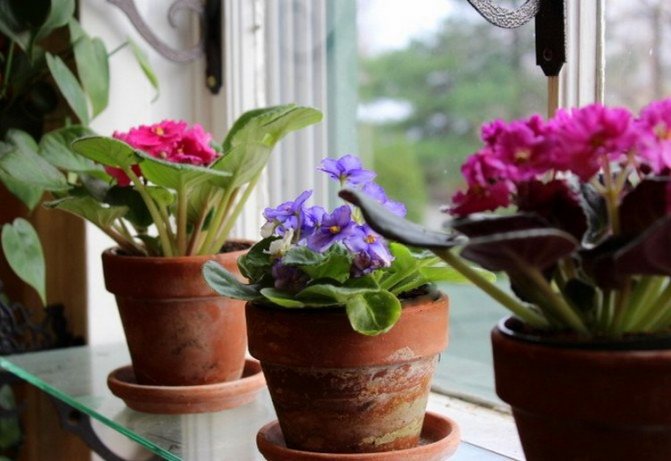

Transplanting a violet is not very difficult, the main thing is care after transplanting a flower and in the future. Which one to choose from the methods of transplanting violets is up to you.
loading ...
Home psychologist
This flower is really capable of healing the soul, therefore people with weak energy are very susceptible to its influence: they just feel good in the room where the violet grows.
Psychologists know that when a person calms down, he becomes relaxed, which has a beneficial effect on the work of the heart, helps to normalize blood pressure, as a result of which headaches go away. In this case, thoughts are ordered, and the subject finds a solution to his problems.
As for family relationships, quarrels and nervous breakdowns do not often look into a house where violets grow. By the way, this flower is a sensitive barometer of energy health in the home: if household members often quarrel, then the plant will soon begin to fade. And this is quite understandable: if the family is not doing well, then there is no time for floriculture. Therefore, the right moment is missed when it is necessary to transplant violets, and watering can be carried out irregularly.
A few tips in the end
- Do not rush to remove the "kids" from the mother sheet. Let them grow at least three pairs of leaves.
- Remember the rule: first, the mother's leaf is separated from the group of "children", and only then the "children" themselves are separated.
- When seating "children", as well as when transplanting an adult violet or transferring, be careful not to deepen the growth point. This is the "Achilles' heel" of Saintpaulia, primarily prone to rot and pests.
- Do not exclude completely white "babies" from variegated varieties, even if they look large. Wait for green leaves to appear.
- Transfer only when the roots of the earthen coma are completely entwined.
- If your violet is more than three years old, it is better to "rejuvenate" it by re-rooting, with a complete pruning of the root system. This will preserve the varietal characteristics of the plant.
The cover photo of the article is studia.marmelad.
What if it's time to plant a blooming violet?
Transplant a blooming violet Not recommended... You need to wait until the end of flowering.
But it so happens that it is high time to plant a violet with rosettes, and the mother bush continues to form buds. Then the violet is planted as expected. BUT on an adult Saintpaulia, all flowers and buds are cut offso that all the energy is spent on restoring the root system.

